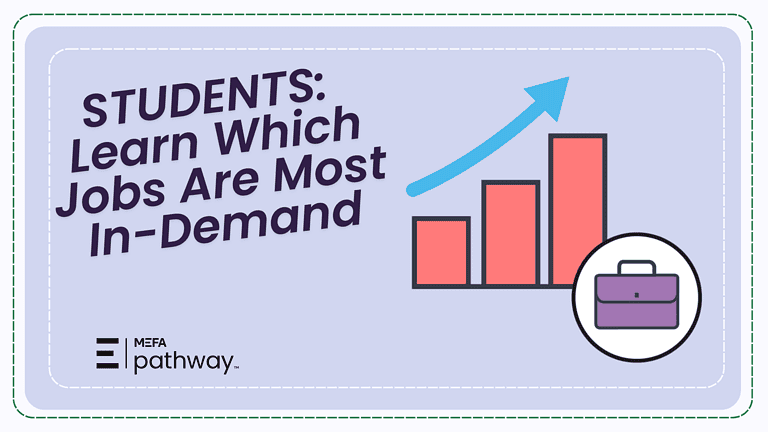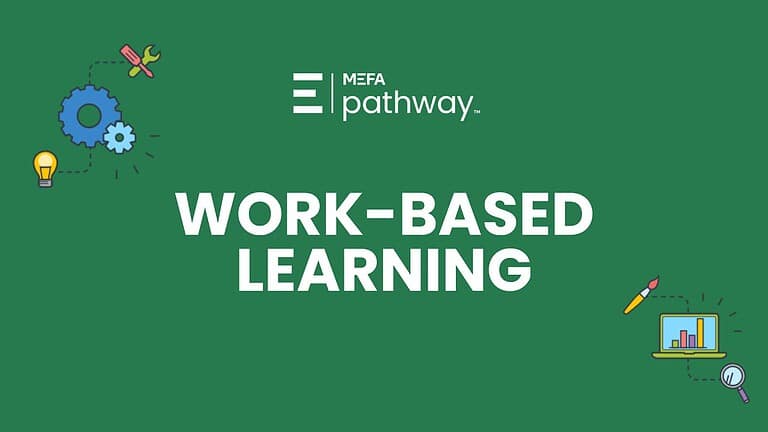Are you considering community college? It’s not too late! In this August 2023 webinar, learn how you can use the free college and career planning website MEFA Pathway to find the perfect community college for you in Massachusetts and learn how to save on the cost by using the MassTransfer program.
Please note that this transcript was auto-generated. We apologize for any minor errors in spelling or grammar.
[00:00:00] Hello, welcome to this MEFA webinar on saving Money on Community College with mass transfer. In this webinar, you’ll learn how you can use the free college and career planning website MEFA Pathway to find the right community college in Massachusetts. You’ll also learn how to save on the cost by using the mass transfer program.
This webinar is also a part of MEFA’s. The Time is Now Campaign and you can learn more about the time is now campaign. By going to this page right here where it says MEFA.org/your future. And this campaign is really geared towards, um, students who are still trying to figure out, um, their plans for their future.[00:01:00]
On this page, you’ll find great resources about, um, MEFA Pathway, of course, any additional webinars, um, and also recorded webinars that we have done. And just more helpful, uh, information about this campaign, this very exciting new campaign that, um, MEFA is, is doing. Alright, so as mentioned before, this webinar is on saving money on community college with mass transfer.
My name is Asia Stut. I am the MEFA Pathway Program coordinator. I joined MEFA as an intern in 2016 as part of the college planning team. Um, and then I’ve transitioned from, um, from that to MEFA Pathway and I’ve joined, um, this amazing. [00:02:00] Team ever since, and I look forward to sharing you all about EFA pathway and diving in a bit more about the mass transfer um, program.
A little bit about MEFA. If you’re not familiar. MEFA is a state authority that was created by the Commonwealth of Massachusetts in 1982. Our mission is to help families plan, save, and pay for college. If you want, would like to learn more about MEFA and all that we offer, definitely encourage you to go to mefa.org.
We have a host full of guidance content, uh, videos, webinars, all great information for students, families, and also educators. Just a, a quick house keep housekeeping note, um, on how you can participate. In this webinar. So, um, if you have any questions, I [00:03:00] encourage you to use the q and a feature, um, throughout the webinar.
I will definitely try to take a peek at those questions. Um, and, and if you have any questions that you would like to ask, definitely feel free to put that on there. Um, encourage questions. Definitely. Um, want you guys to have any questions, feedback comments, all of that is welcome. Um, this webinar is also live trans transcript, so, um, you can select the CC button if you need live, um, transcript for closed captioning.
Um, if you have to leave this webinar at any point in time, I encourage you Definitely utilize the. Red leave button. And then also, um, to the left is the audio settings, which you’ll also find in the zoom window. So if you need to control your volume levels or anything like that, um, definitely feel free to do that.
[00:04:00] All right, so let’s get started. So, as mentioned before, um, MEFA Pathway is a free college and career planning platform for students in grades six through six through 12 to help them think about their post-secondary success. You know, one thing that I love about MEFA Pathway is that we really support the idea that.
No one journey is the same. Uh, there are students that might want to go to a four year college. Uh, students that might want to go to a two year, maybe they go into a trade or the military or anything in between. Uh, there’s really something for everyone. I. A pathway and just knowing that, you know, there’s no two journeys that that’s the same, and being supportive of that I think is one of the definitely, you know, things that I love about Eha Pathway.
So I’m on eha [00:05:00] pathway.org. As you can see, I’m going to select, I am a student. So as students get to this page, if they do not have a Miha Pathway account, then we encourage that they register for oh one again, the registration process, um, aha pathway is free. So we will never charge to, uh, create an account or anything like that.
Um, the registration process is pretty straightforward, so we’re just gonna put in first name, last name, date of birth, and then the city or town the school is in, as well as the school itself. So I’ll just put in a name of a, of a student for an example.
And then we’ll put Boston as my senior town, [00:06:00] and then we will just do Boston Arts Academy. And then I’ll hit submit.
So now this, once you fill out that first page, then it will bring you to another. Page in the registration process where you’ll want to fill out the remaining information such as your address, city zip code. Um, you’ll, the phone number is optional and then the expected year of graduation. Now, the expected year of graduation is important because the year that is selected for that will dictate.
The kind of information that is displayed in the NEFA Pathway student experience. So we offer age appropriate and grade level activities. So if you are in high school, you’ll see high school activities. If you are in middle school, you’ll see middle school [00:07:00] activities. Uh, the student portal is one.
Platform, one experience, but, um, middle school students see different activities than, um, high school experience. High school students. There are some similarities, but for the most part, uh, we keep all the activities focused on grade level and age appropriate. So I’ll just continue to finish putting in this information.
I won’t actually, uh, hit the submit button, but just so that you can understand some of the information that is required in the registration process.
So once you fill out both of these registration pages, you’re gonna wanna hit register. Again, I encourage you to create your own account so that way you can also experience Muha Pathway. But for the sake of this webinar, I just wanted to show you [00:08:00] what the registration process, uh, looks like and entails.
But since I already have an account for Meha Pathway, I’m just gonna log in with my information, so my username and password.
All right, so we are logged in. I am in my test account for Zoe. We can see that Zoe is a 12th grader at Brockton Champion High School. Uh, this is Zoe’s dashboard. Um, we can see that on the dashboard there are a variety of activities that Zoe can complete or maybe she hasn’t yet updated her course plan.
Um, maybe that’s something that she can work on, um, or maybe she has already. Completed goals and strategies. Um, the progress gauge will [00:09:00] let students know, um, whether or not, um, you have either completed it or the last activity date for that particular activity on the dashboard, we also have a featured video page, so students will be able to view videos, um, meet the pathway that have been created by, uh, members of the college planning team.
And we also have a featured scholarship listed here. Um, MEFA Pathway does feature a scholarship search tool, and that is an amazing tool that you can utilize to search for scholarships and just have a place to also add scholarships to your list. MEFA pathway also translates into six languages. We have English, Chinese, simplified Haitian, Creole, Portuguese, Spanish, and Vietnamese.
So I’ll just select Spanish just so that you [00:10:00] can see what MEFA pathway looks like in a different language.
All right, so now I’m gonna just put it back to English for a second. Alright, perfect. So now, because again, the focus of this webinar is mass transfer. I’m going to hover over to search colleges. Here you’ll find a variety of features on in this menu navigation bar at the top. Where we are gonna spend some time today is around mass transfer.
I’ll showcase the my mass transfer benefits. And then lastly, we’ll also talk about a little bit of the college compare. So the first place we’re gonna go is mass transfer. So Mass transfer is a program that allows students to [00:11:00] start at a community college. And then select a state school that they would like to transfer into.
Um, the costs that students save are estimates, um, and they only include tuition and fees. Um, students may incur additional costs that relate to being a college students, like housing, a meal plan, books, and any additional. Expenses. But mass transfer is a great program for students to know that they can start at a community college, um, get their associate’s degree, and then transfer into a state school, um, and, um, finish off their, um, degree.
All right, so I’m going select a school from this drop. Um, we’ll just do Mass Bay Community College. And then for my school that I would like to transfer into, I do Mass College of Art in [00:12:00] design now. So if students select a starting community college and then they select a school within mass transfer that they are interested in, or they would like to transfer into.
You’ll see that there are three types of programs. There’s the Gen Ed Foundation program where a student will do one year at community college and then they’ll do three years at mass art. Their estimated savings, if they were to do this program, um, is a little over $7,000. For the duration of this program.
And then you can also see what the total estimated costs for four years would be if you decide to do this Gen ed Foundation program. If you would like to learn more about the gen ed program, um, you can select this gray learn more button. [00:13:00] And that will bring you to the Gen Ed Foundation program, um, where you can learn more directly about their program, the credits that are required, um, the different types of majors, um, and just more information about that program.
Next we have the A to B program. So with the A to B program, students will do two years at a community college, in this case, mass Bay Community College. Then they’ll do, they’ll do two years at Mass College of Art and Design. Their estimated savings is a little over $17,000, whereas their estimated cost for four years is 40, a little over $42,000.
Similarly, if a student is interested in the A to B program, um, they can also select the learn more button, and this will take [00:14:00] them to. A more detailed page about mass transfer, um, the mass transfer A to B degree program. Um, again, students can look about different majors. Um, maybe the number of credits, maybe the number of the minimum GPA that might be required, um, how they can apply for the program.
Great information like that. Last but not least, we have the Commonwealth Commitment Program where students will do two years at a community college and then two years at a state university. Their estimated savings is a little over 24,000. And then we can also see the total estimated cost for four years.
Um, a little over 35,000. Similarly to the previous two programs, if students are interested in this plan, um, or they can learn more by [00:15:00] selecting a learn more button. And this will take them to a more detailed page about the mass transfer program. So we can see our, our majors here that are listed, um, the directory, how to get started.
All that great information. So let’s say that you have put in your community college of choice and you put in your state school and you see that there are three great programs and you’re, uh, not sure which one that you wanna select, but the Gen Ed Foundation program sounds interesting to you. So what you wanna do is collect the Save This Plan button.
You can also name your plan if you’d like, but for the sake of this webinar, just keep it the name that’s already pre-populated and select save. The nice thing about MEFA [00:16:00] Pathway is as you complete different features and activities within MEFA Pathway, you’ll be prompted with additional activities that you can do next.
So we’re being prompted to go to the college calculator, the College Compare, um, maybe create another plan, um, different activities you can definitely do after you complete an activity within the pathway. But for the sake of the webinar, we’ll just exit this window and we’ll go to mass transfer, my mass transfer benefits page.
All right, so the, the plan that I just saved in that previous screen, um, will bring you to the my Mass Transfer benefits page. The great thing about this list be is that it will list any plan that. A student has saved. So whether it’s the Gen ed Foundation program, the A to B program, or the Commonwealth Commitment Program, um, students [00:17:00] can use this list to save their, their programs of in, of interest.
But maybe there’s a program or plan that they are no longer interested in, they can easily remove a plan from the list. By selecting the X button under remove, students can also add more plans by selecting this add more plans button, and it’ll bring them back to the, um, page where you’ll start. Uh, you’ll, you’ll select a community college and then select a, a state school.
So we have our list of plans that we’ve added from mass transfer. We can see them listed here. We can see our program name, the starting school, and then the transfer to school. Next, I’m going to hover to the college compare. [00:18:00] So the great thing about the college compare is that you can compare up to five colleges at one time.
So whether you want to pull in colleges directly from your college list, or you wanna pull in from your mass transfer benefits list or combination of both, you can do that. You can also pull in colleges from the browsing, uh, feature or even search by college name. Uh, for the sake of this webinar, I’ll pull in a combination for my college list and also for my mass transfer benefits page.
Um, before I do that, I do wanna mention that if you complete the college compare, you can actually save your comparison. So, um, maybe you’ve put in your college list schools and your mass transfer benefits program and you wanna save that comparison to come back to it. You can do that at any point in time.[00:19:00]
So you even happen to exit Eco Pathway and come back. You just select the save or load comparison button and you’ll see a list of all of the comparisons that you, uh, saved in the college Compare. All right, so going to select a college list. So we’ll do LaSelle University ’cause that’s actually my alma mater, and then we will do Boston University.
And we’ll do, we’ll do an out state, we’ll do U Maine. Alright. And then we’ll also do our mass transfer benefits schools, our programs. Uh, we’ll do gen ed and then we’ll do A to B.
So we have our five schools listed. I’m gonna keep my criteria as, um, what you see [00:20:00] listed here, so I’m not going to uncheck, um, key factors, undergrad information, tuition and fees or academic info. I typically, um, like to keep it checked, but if you do the comparison yourself and you would like to, um, deselect any of these, that’s totally fine too.
Um, and then I also, uh, just leave my preferences blank. Um, I just figured, um, we can just do that. So now I’m going to show comparison.
All right, so we can see through our comparison the on the purple. Um, so on my left, the purple are the mass transfer, um, program, schools, or plans. And then to my right or the blue, are the schools that were added that were I added to my college list. So for Bunker Hill Community College to [00:21:00] Salem State, through the gen ed program, we can see key factors like type of school, um, size, location.
We can see information about undergraduate data. Um, we can also see an estimate of in-state and out-of-state tuition. You’ll see the net price calculator and then also. More information about SAT scores and, um, academic information. So if a student were to do this program, program here, their estimated, um, you know, savings, um, would be around 2,500, um, compared to a traditional bachelor’s program at Salem State University.
Um, the next that you see in purple is the mass transfer program or the A to B program. Um, and that is starting at Roxbury Community College and transferring into UMass Lowell. Um, again, we can see. [00:22:00] Key factors such as type of school, the setting, the size, um, information about undergraduate data, um, and then the estimated tuition and fees for this particular program Here is 18,626 in savings compared to a traditional bachelor’s program at UMass Lowell.
Again, students will still wanna meet, um, the requirements that are in each mass transfer program, but it’s great that students can use the mass, um, transfer program, but also the college compare to look at different options. And then we also have a course the. Colleges that were added from my list. So we have the Cell University, Boston University, and Humane.
Um, we can see again key factors, undergraduate information, um, [00:23:00] tuition and fees. Out-of-state tuition, net price calculator, and just more information at the bottom about academics and test scores. So if you look at just the estimated tuition and fees for all of five schools or the three schools and then the two programs that we have listed, you can see just about.
You know what the in-state tuition and fees would be, what outta state would be, and then also what the potential, um, possibilities are for savings. So if a student decided to. Go to RCC for two years and then complete two years at UMass Lowell, then, you know, they would, you know, have the capacity to definitely save, um, on their tuition and fees cost, um, comparing if they, um, did not go to mass through a mass transfer program.
But, um, this is a nice way [00:24:00] to give. Students an option to compare any school or program that they are interested in. And again, if you put in your comparisons and you would like to save them, you again, just select the save or load comparison button. I have a couple comparisons save, so I’ll just do a comparison.
And then, you know, maybe you have saved your comparisons and you want to, um, you know, remove any of them. You can hit the X button, maybe you wanna show additional comparisons. You can just select that button, um, the show comparison button, and you’ll be able to view additional comparisons that, um, you have saved in Mefa Pathway just to show.
Comparison, and then you’ll see the same thing, um, [00:25:00] if you put in your mass transfer, um, program, schools, or even your, um, college list schools.
All right, I’m gonna head back over to our presentation
if you.
If you have, um, if you follow MEFA on social media, um, we are on Facebook, we are on Twitter, we are on Instagram, um, we are on LinkedIn, YouTube, and we are also, um, we have a MEFA podcast. Um, and we encourage you, definitely stay connected with us. These are our social media, um, channels and, uh, where you can find us.
And then of course, if you have any questions about, [00:26:00] um, MEFA, um, MEFA pathway or just anything in between, definitely feel free, um, to get in touch with us. We welcome, um, helping families and students, um, on their journey and we definitely. Um, are here to help you in any way that we can. And I thank you all for joining this webinar and I hope that you all have a great rest of your day.
Thank you.













